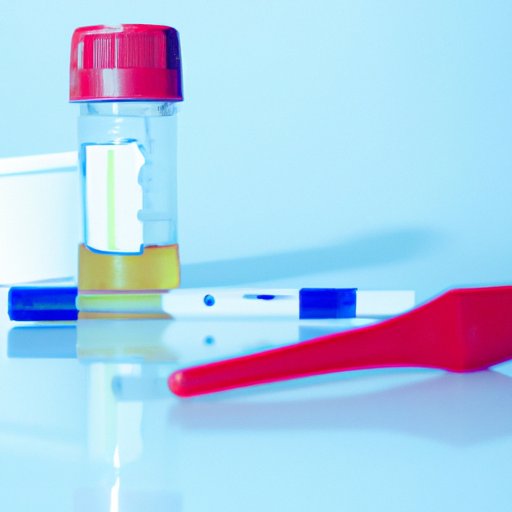
I. Introduction
pH is a term that you might have heard before, but what does it really mean? pH is a measure of acidity or alkalinity of a substance, and it is important to understand pH because it plays a critical role in many daily processes. This article is designed to provide you with a step-by-step guide on how to calculate pH, tips for measuring pH accurately, and also dispel common misconceptions. By the end of this article, you will have a better understanding of pH and its importance in our everyday lives.
II. A Step-by-Step Guide for Calculating pH
To understand pH, it is important to first define what it is and how it is measured. pH is a measure of the concentration of hydrogen ions in a solution and is usually expressed on a scale of 0 to 14. A pH of 7 represents a neutral solution, a pH below 7 is acidic, and a pH above 7 is alkaline. The equation used to calculate pH is pH = -log[H+].
Breaking down this equation, you first need to find the concentration of hydrogen ions in the solution, which is represented by [H+]. This can be measured using a pH meter or calculated using the concentration of a strong acid or base in the solution. Once you have [H+], you take the negative log of that to get pH.
For example, if you have a solution with a hydrogen ion concentration of 10^-3 moles per liter, the pH would be calculated as follows: pH = -log(10^-3) = 3.
It is important to note that the pH scale is logarithmic, meaning that a change of one pH unit represents a ten-fold change in hydrogen ion concentration. So, a solution with a pH of 3 is ten times more acidic than a solution with a pH of 4.
To aid in the calculation of pH, there are several charts and tables available that provide information on the pH of common substances. Additionally, there are online calculators available that make it easy to calculate pH with just a few clicks.
III. Tips for Measuring pH Accurately
When it comes to measuring pH, accuracy is key. Inaccurate measurements can lead to incorrect conclusions and potentially dangerous situations. To measure pH accurately, you will need specialized equipment such as a pH meter or test strips.
Before measuring pH, it is important to calibrate your equipment, ensuring that it is performing as expected. pH calibration solutions can be purchased to aid in this process. Additionally, equipment should be regularly maintained and cleaned to ensure accuracy and longevity.
When measuring pH, it is important to take multiple readings to ensure accuracy. Additionally, readings should be taken in a representative portion of the solution being measured to avoid skewed results.
Common mistakes to avoid when measuring pH include using expired calibration solutions, exposing equipment to temperature extremes, and failing to rinse equipment between measurements.
IV. The Importance of pH in Everyday Life
Now that we have a better understanding of how pH is measured, let’s explore the importance of pH in everyday life.
One example of how pH affects our daily lives is through our diet. Many foods are acidic, such as citrus fruits and vinegar, and alkaline, such as kale and spinach. Maintaining an appropriate balance of acidic and alkaline foods is important for maintaining a healthy diet and preventing issues such as acid reflux.
In addition to food, pH plays a critical role in water quality and the environment. pH affects the solubility and mobility of contaminants in water, which can impact plant and animal life. Additionally, some specific environments, such as acidic hot springs, can support unique ecosystems that are not found elsewhere.
Interesting facts about pH include that the pH of the human stomach can be as low as 1, and that the pH of household bleach is around 12.5!
V. Case Studies in pH Measurement
Real-world examples of how pH is used include in chemical reactions, drug development, and water treatment. For example, pH is critical in the manufacturing of pharmaceuticals, as the pH of the solution can impact the effectiveness and shelf life of the drug. In water treatment, pH is used to determine the chemical dosing necessary to achieve optimal water quality.
VI. pH Measurement Alternatives to Traditional Methods
While traditional methods of measuring pH, such as pH meters and test strips, remain popular, several innovative approaches have been developed in recent years. One alternative method is the use of digital pH meters, which provide increased accuracy and enable data to be saved and transferred digitally. Another option is the use of disposable test strips that change color based on the pH of the solution being measured.
While alternatives to traditional methods offer advantages, some also have drawbacks. For example, disposable test strips may not be as accurate as other methods and may not provide measurements for a wide range of samples.
VII. Common Misconceptions About pH
One common misconception about pH is that acidic foods are always bad for you. While some acidic foods, such as citrus fruits, can be detrimental to dental health if consumed in excess, many acidic foods are actually beneficial and contain essential vitamins and minerals.
An additional misconception is that a basic solution is equivalent to a safer solution. While some alkaline solutions, such as baking soda, can be used safely in certain contexts, strong bases can be highly caustic and corrosive and pose potential health risks.
VIII. Conclusion
In conclusion, understanding pH is important for many aspects of daily life, from diet to water quality and beyond. By following the step-by-step guide provided, measuring pH accurately is achievable. Remember to calibrate and maintain equipment and avoid common mistakes, such as using expired calibration solutions. Innovative approaches to pH measurement offer alternative options, and misconceptions can be debunked. With a better understanding of pH, we can make informed decisions that positively impact our health and the environment.





